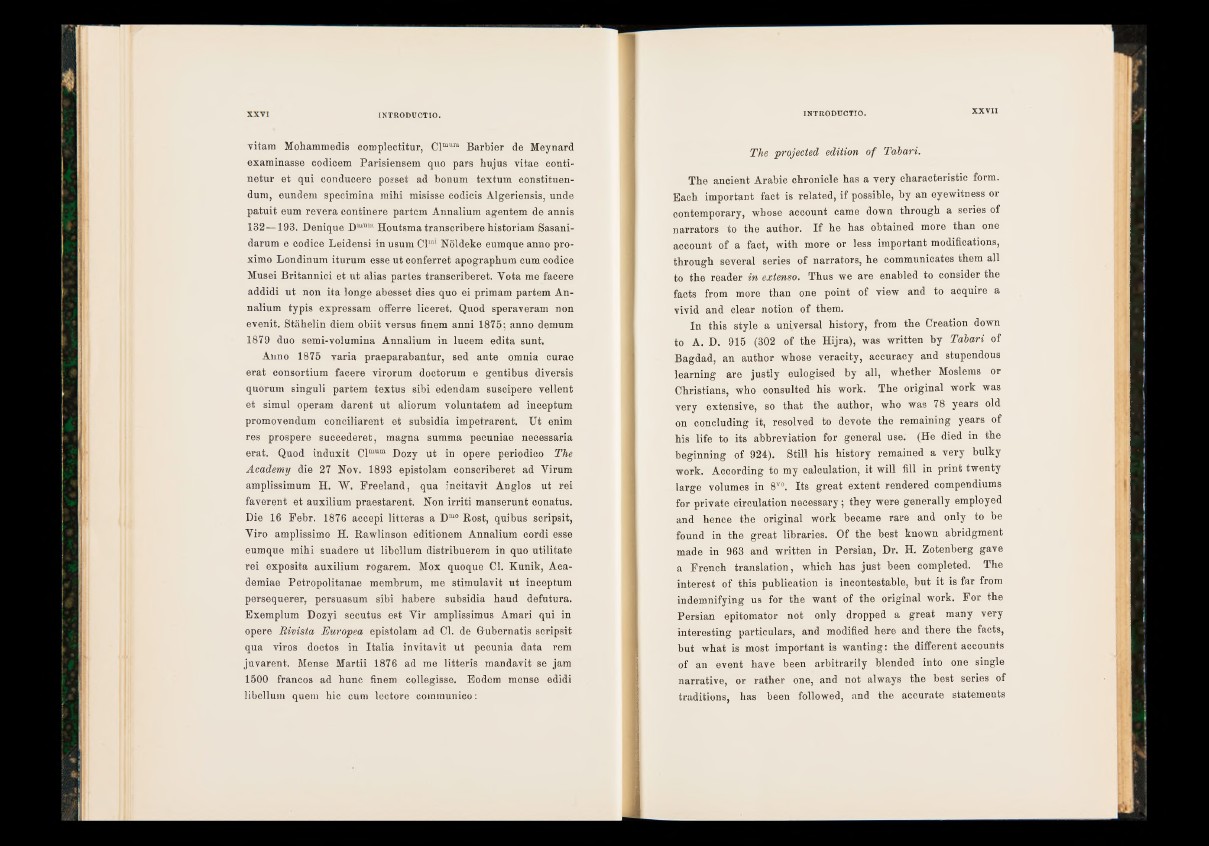
INTBOmiCTIO. INTRODUCTIO. XXVII
vitara Mohammedis compleotitur, Cl™“™ Barbier de Meynard
examinasse codicem Parisiensem quo pars bujus vitae conti-
n e tu r e t qui conduoere posset ad bonum tex tum co n stitu en dum,
eundem specimina mihi misisse codicis Algeriensis, unde
p a tu it eum rev e ra continere partem Annalium agentem de annis
132 —193. Denique D*"““ Houtsma tran sc rib e re historiam Sasani-
darum e codioe Leidensi in usuni Cl“" Nöldeke eumque anno proximo
Londinum itiirum esse u t conferret apographum oum codice
Musei B ritan n ic i e t u t alias partes tran so rib e re t. Vota me facere
addidi u t non ita longe abesset dies quo ei primam p artem Annalium
typis expressam offerre liceret. Quod speraveram non
evenit. Stäb elin diem obiit versus finem anni 1875; anno demum
1879 duo semi-volumina Annalium in lucem éd ita sunt.
Anno 1875 v aria p ra ep a rab an tu r, sed an te omnia curao
e ra t consortium facere virorum doctorum e gentibus diversis
quorum singuli partem tex tu s sibi edendam suscipere ve llen t
e t simul operam d a re n t u t aliorum voluntatem ad inoeptum
promovendum conoiliarent e t subsidia im p e tra ren t. Ut enim
res prospéré su c c ed e re t, magna summa pecuniae necessaria
e ra t. Quod in d u x it Cl'““'“ Dozy u t in opere periodico The
Academy die 27 Nov. 1893 epistolam conscriberet ad Virum
amplissimum H. W. F re e la n d , qua in c itav it Anglos u t rei
fav eren t e t auxilium p ra e sta ren t. Non irriti man seru n t oonatus.
Die 16 F eb r. 1876 accepi litte ra s a D“ " Kost, quibus scripsit,
Viro amplissimo H. Rawlinson editionem Annalium cordi esse
eumque mib i suadere u t libcllum distribuerem in quo u tilita te
re i exposita auxilium rogarem. Mox quoque Cl. Kunik, Aca-
demiae P e tro p o litan a e membrum, me stimu lav it u t inceptum
persequerer, persuasum sibi h ab e re subsidia baud defutura.
Exemplum Dozyi secutus est Vir amplissimus Amari qui in
opere Rivista Europea epistolam ad Cl. de Gubernatis scripsit
qua viros doctos in I ta lia in v ita v it u t pecunia d ata rem
ju v a re n t. Mense Martii 1876 ad me litte ris mandavit se jam
1500 francos ad bunc finem collegisso. Eodoni mense edidi
libollutn quem hie cum lecto re coraraunico:
The projected edition of Talari.
The ancient Arabic chronicle has a v e ry ch a ra c te ristic form.
Each im p o rtan t fact is related , if possible, by an eyewitness or
contemporary, whose account came down th ro u g h a series of
n a rra to rs to th e author. I f be has obtained more th a n one
account of a fact, with more or less important modifications,
th ro u g h several series of n a rra to rs, he communicates them all
to th e re ad e r in extenso. Thus we a re enabled to consider th e
facts from more than one point of view and to acquire a
vivid and clear notion of them.
In this style a universal h isto ry , from tb e Creation down
to A. D. 915 (302 of th e Hijra), was w ritten by Tala r i of
Bagdad, an au th o r whose v e ra c ity , accuracy and stupendous
le a rn in g are ju s tly eulogised by all, whether Moslems or
Christians, who consulted bis work. The orig in a l work was
very extensive, so th a t th e author, who was 78 years old
on concluding it, resolved to devote tb e remaining years of
his life to its abbreviation for general use. (He died in tb e
b e g in n in g of 924). Still his h isto ry remained a v e ry bulky
work. According to my calculation, it will fill in p rin t tw en ty
la rg e volumes in 8''". Its g re a t ex te n t rendered compendiums
for p riv a te circulation n e c e ssa ry ; they were g enerally employed
and hence th e original work became ra re and only to be
found in th e g re a t libraries. Of tb e b e st known ab rid gmen t
made in 963 and w ritten in P e rsian , Dr. H. Zotenberg gave
a F re n c h tra n s la tio n , which has ju s t been completed. The
in te re s t of this publication is incontestable, b u t it is fa r from
indemnifying us for tb e want of th e orig in al work. F o r the
P e rsian epitomator n o t only dropped a g re a t many very
in te re stin g particulars, and modified h e re and th e re tb e facts,
b u t wb a t is most im p o rtan t is w an tin g : tb e different accounts
of an event have been a rb itra rily blended into one single
n a rra tiv e , or ra th e r one, and not always tb e b e st series of
trad itio n s, has been followed, and tb e a c cu ra te statements